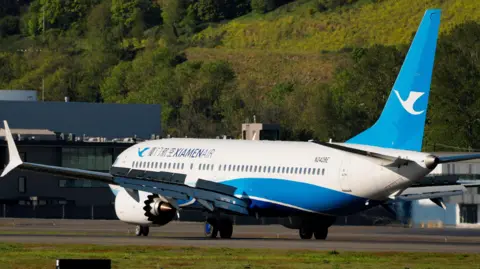In a significant and ongoing saga of international trade tensions, China has commenced the return of Boeing aircraft ordered from the United States. This move signals a notable escalation in the retaliatory measures inspired by the tariffs imposed by the Trump administration. Kelly Ortberg, the CEO of Boeing, confirmed that two planes have already been sent back, and an additional aircraft is expected to follow. This response highlights how geopolitical dynamics significantly influence global commerce, particularly in the aviation industry, making it a pivotal point for stakeholders involved.
The backdrop to this situation is a deeply complex trade relationship between the U.S. and China, which has been marred by escalating tariffs. The United States enforced a staggering 145% tariff on Chinese imports, which prompted China to retaliate by imposing a 125% tax on U.S. goods. Such high tariffs have not only strained bilateral relations but have also had dire ramifications for American businesses that rely heavily on Chinese markets. Boeing, as the largest exporter in America, is facing a particularly harsh impact, alongside significant dependencies on international agreements for sustaining its commercial aircraft sales.
As part of the fallout from the tariff environment, Ortberg noted that while Boeing was anticipating another 50 aircraft deliveries to China this year, the customers had indicated a reluctance to accept delivery, effectively halting transactions. This development has immediate ramifications for Boeing’s production and financial outlook, prompting the company to seek alternative avenues. Ortberg expressed that Boeing is considering options to re-market 41 already completed planes to different customers due to high demand from airlines not affected by the tariffs.
The trade war narrative was further encapsulated during President Trump’s remarks in the Oval Office, where he expressed optimism regarding potential improvements in trade discussions with China. However, he emphasized that tariffs would not completely diminish, reiterating that substantial barriers would remain in place. This statement underscored a duality within the current administration—the desire for diplomatic engagement while also maintaining a firm stance against perceived unfair trade practices.
In response to these challenges, Boeing is actively engaging with the Trump administration to navigate through the complexities of the trade war. Ortberg articulated that there is almost a daily dialogue with high-ranking officials or even President Trump himself regarding the evolving trade dynamics and their consequences for the aviation sector. This frequent communication aims to align Boeing’s needs with national policy efforts to mitigate the adverse effects of tariffs.
Furthermore, Scott Bessent, America’s Treasury Secretary, pointed to the possibility of a “big deal” emerging from upcoming negotiations. Bessent’s comments suggest that there is a glimmer of hope for a resolution, contingent upon tangible changes in China’s economic strategies, particularly reducing its reliance on manufacturing exports. This context illustrates that diplomatic efforts remain at the forefront of addressing the challenges facing U.S. businesses involved in international trade.
As the situation progresses, it’s notable that the broader American economy and the supply chains connected to Boeing are also under pressure. Ortberg highlighted that several suppliers, particularly those based in Japan and Italy, are starting to feel the financial pinch due to newly implemented universal tariffs. Preparing for production increases, Boeing aims to ramp up its output of 737 MAX jets amid recovery efforts following previous declines attributed to various crises, including labor strikes.
In conclusion, the interplay of international trade policies, corporate strategy, and geopolitics is decidedly intricate. Boeing’s current predicament reflects a microcosm of the larger economic debate surrounding trade tariffs and their implications for American industry. The aviation manufacturer is working diligently not just to reposition its market offerings amidst these challenges, but also to advocate for favorable negotiating outcomes through continued dialogue with U.S. policymakers. As the story unfolds, it is evident that solutions will require a collaborative approach, engaging various stakeholders from government to industry in what is becoming an urgent economic conversation.



